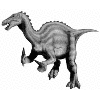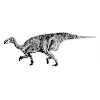CLASSIFICATION
| Iguanodon Mantell, 1825TYPE SPECIES: I. bernissartensis Boulenger & van Beneden, 1881 OTHER SPECIES: I. anglicus Holl, 1829 “English Iguana tooth” I. atherfieldensis Hooley, 1924 I. dawsoni Lydekker, 1888 I. fittoni Lydekker, 1889 I. hoggi Owen, 1874 I. lakotaensis Weishampel & Bjork, 1989 “Iguana tooth from the Lakota Formation” I. ottingeri Galton & Jensen, 1979 [nomen dubium] ?I. sp. MISASSIGNED SPECIES: I. exogyrarum Fritsch, 1878 [nomen dubium] = “Ponerosteus” exogyrarum I. foxii (Huxley, 1869) (originally Hypsilophodon) = Hypsilophodon foxii I. gracilis Lydekker, 1888 [nomen dubium] “gracile Iguana tooth” == I. atherfieldensis I. hilli Newton, 1892 [nomen dubium] == Craspedodon lonzeensis I. hollingtonensis Lydekker, 1889 == I. fittoni I. major (Owen, 1842) [nomen dubium] (originally Streptospondylus) == Iguanodon anglicus I. mantelli von Meyer, 1832 “Gideon Mantell’s Iguana tooth” == I. anglicus I. mongoliensis Whitfield, 1992 [nomen nudum] “Iguana tooth from Mongolia” == Altirhinus kurzanovi I. orientalis Rozhdestvensky, 1952 “eastern Iguana tooth” == I. bernissartensis == Altirhinus kurzanovi I. phillipsii Seeley, 1869 [nomen dubium] = Priodontognathus phillipsii I. praecursor Sauvage, 1876 [nomen dubium] “forerunner Iguana tooth” == Pelorosaurus humerocristatus I. prestwichii (Hulke, 1880) (originally Cumnoria) = Camptosaurus prestwichii I. prestwichii Sauvage, 1897 == Teinurosaurus sauvagei I. seeleyi Hulke, 1882 == I. bernissartensis I. suessi Bunzel, 1871 [nomen dubium] == Rhabdodon priscus I. valdensis (Hulke, 1879) (originally Vectisaurus) == Iguanodon atherfieldensis I. valdensis (Lydekker, 1889) [nomen dubium] (originally Camptosaurus) == Valdosaurus canaliculatus | Animalia Vertebrata Tetrapoda Sauropsida Archosauromorpha Ornithodira Dinosauria Sauropodomorpha |
see also: Genus Index, Classification
MEASUREMENTS
TIME
I. bernissartensis: Barremian
I. anglicus: Valanginian
I. atherfieldensis: Barremian
I. dawsoni: Valanginian
I. hollingtonensis: Valanginian
I. sp.: Late Jurassic
see also: Ages of the Mesozoic
PLACE
I. bernissartensis: Belgium, England, Germany, Spain, Mongolia? & France, Tunisia?
I. anglicus: England
I. atherfieldensis: Belgium, England, Germany, Spain
I. dawsoni: England
I. fittoni: England, Spain
I. hoggi: England
I. lakotaensis: S. Dakota
I. ottingeri: Utah
I. sp.: U.S.A.
REMAINS
- I.bernissartensis
- I.anglicus
- teeth, fragments
- I.atherfieldensis
- 3 complete skeletons, partial skeletons, teeth, postcrania (juvenile to adult)
- I.dawsoni
- 2 partial skeletons
- I.fittoni
- 3 partial skulls
- I.hoggi
- lower jaw
- I.hollingtonensis
- several specimens
- I.lakotaensis
- skull, vertebrae
- I.ottingeri
ESSAY
| This was the first dinosaur to be scientifically recognized. Along with Megalosaurus and Hylaeosaurus it was one of the first three creatures to be placed in Dinosauria. Iguanodon was originally restored as a four-legged, rhinoceros-like beast. Later the “nasal horn” turned out to be a thumb spike. Its posture was changed to bipedal, since its hindlimbs were so much longer than its forelimbs. Nowadays it, like other large iguanodonts, is thought to have been facultatively bipedal, that is, primarily quadrupedal, but capable of moving on two legs as well. Iguanodon as shown here may be a paraphyletic genus, with some species closer to hadrosauroids than others. As with most old genera, there is some taxonomic sorting to be done. The original type species (I. anglicus) is based on very poor material, and thus the type was recently changed to the better-known I. bernissartensis by the ICZN. I. hollingtonensis and I. atherfieldensis were rather gracile and long-spined, while I. dawsoni and I. bernissartensis were more robust and short-spined. |
IMAGES
Click on thumbnail to see full image.
| CHRISTOPHER SRNKA Digital (Two-Dimensional) |

Iguanodon, the first (non-neornithean) dinosaur to be named. |
